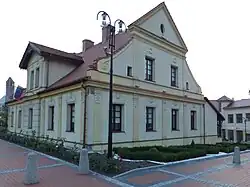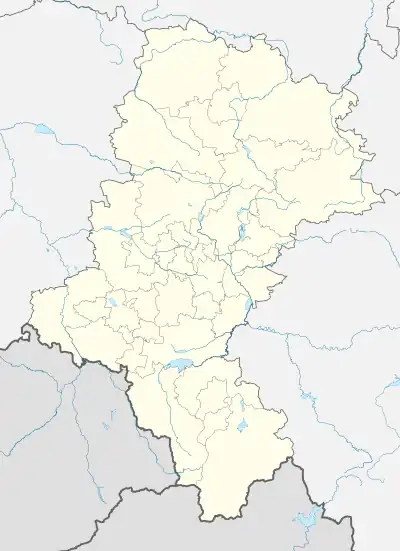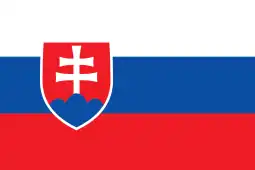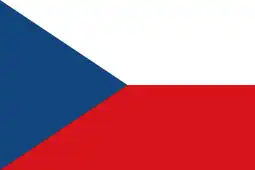Lędziny
Lędziny ([lɛnˈd͡ʑinɨ]; German: Lendzin; Silesian: Lyńdźiny) is a town in Silesia in southern Poland, near Katowice. It borders the Upper Silesian Metropolitan Union – a metropolis with a population of 2 million which is located in the Silesian Highlands. The population of the town is 16,776 (2019).
Lędziny | |
|---|---|
 Library in the town centre | |
 Coat of arms | |
 Lędziny  Lędziny | |
| Coordinates: 50°7′37″N 19°6′44″E | |
| Country | |
| Voivodeship | |
| County | Bieruń-Lędziny |
| Gmina | Lędziny (urban gmina) |
| Area | |
| • City | 31.48 km2 (12.15 sq mi) |
| Population (2019-06-30[1]) | |
| • City | 16,776 |
| • Density | 530/km2 (1,400/sq mi) |
| • Urban | 2,746,000 |
| • Metro | 5,294,000 |
| Time zone | UTC+1 (CET) |
| • Summer (DST) | UTC+2 (CEST) |
| Vehicle registration | SBL |
| Primary airport | Katowice Airport |
| Website | http://www.ledziny.pl |
It is situated in the Silesian Voivodeship since its formation in 1999, previously in Katowice Voivodeship, and before then, of the Autonomous Silesian Voivodeship. Lędziny is one of the towns of the 2.7 million conurbation – Katowice urban area and within a greater Silesian metropolitan area populated by about 5,294,000 people.[2]
History

The proofs of human habitation dating back to the Bronze Age have been found in a direct vicinity of the town – mostly period pieces of Lusatian culture. In the pre-Christian era, on the highest hill within present borders of the town – Klimont Hill, place of worship dedicated to Slavic god Perun, (modern ablatives Piorun, Pieron – meaning Thunderbolt) was located. Much later, in 1769, Saint Clement Church was raised in exactly the same spot, where pagan place of worship used to be.
In 1160, Lędziny was donated by knight Jaksa of Miechów to the Order of Saint Benedict, as it was mentioned by Jan Długosz. In 1260, it was mentioned in a document of Duke Władysław Opolski issued in Racibórz. It was part of medieval Piast-ruled Poland.
In the 18th century, it was annexed by Prussia, and after 1871 it was part of Germany. Battles of the Polish Silesian Uprisings against Germany were fought in the area, especially during the Second Silesian Uprising in 1920. Afterwards Lędziny was restored to the reborn Polish state.
On September 3, 1939, during the German invasion of Poland, which started World War II, German troops committed a massacre of seven Poles in Lędziny, including a 17-year-old boy and a 16-year girl (see Nazi crimes against the Polish nation).[3] The town was afterwards occupied by Germany until 1945. In 1944, the Germans established a subcamp of the Auschwitz concentration camp in the town, in which they imprisoned hundreds of prisoners, mostly Jews from German-occupied France, Netherlands, Poland and Hungary.[4] In January 1945, the Germans evacuated 600 prisoners on foot to the nearby city of Gliwice.[4]
In 1975 Lędziny was amalgamated with Tychy, but regained town rights in 1991.
Districts
The town is subdivided into 9 districts:
- Blych
- Goławiec
- Górki
- Hołdunów
- Rachowy
- Ratusz
- Smardzowice
- Świniowy
- Zamoście
Twin towns – sister cities
 Revúca, Slovakia
Revúca, Slovakia Roccagorga, Italy
Roccagorga, Italy Uničov, Czech Republic
Uničov, Czech Republic
References
- "Population. Size and structure and vital statistics in Poland by territorial division in 2019. As of 30th June". stat.gov.pl. Statistics Poland. 2019-10-15. Retrieved 2020-02-14.
- European Spatial Planning Observation Network (ESPON) "Project 1.4.3". Archived from the original on 2009-07-28. Retrieved 2009-03-28.
- Wardzyńska, Maria (2009). Był rok 1939. Operacja niemieckiej policji bezpieczeństwa w Polsce. Intelligenzaktion (in Polish). Warszawa: IPN. p. 133.
- "Günthergrube". Memorial and Museum Auschwitz-Birkenau. Retrieved 3 April 2021.
- "MKS Lędziny - Oficjalna strona" (in Polish). Retrieved 3 April 2021.
- "Miasta partnerskie". ledziny.pl (in Polish). Lędziny. Retrieved 2020-03-12.
External links
- Lędziny city government website
- Jewish Community in Lędziny on Virtual Shtetl
- Jewish Community in Lędziny babux
